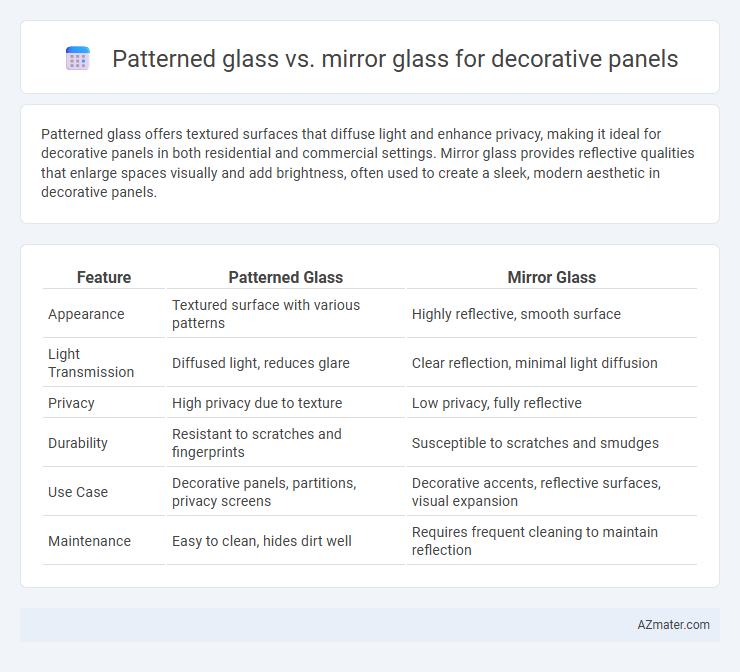Patterned glass offers textured surfaces that diffuse light and enhance privacy, making it ideal for decorative panels in both residential and commercial settings. Mirror glass provides reflective qualities that enlarge spaces visually and add brightness, often used to create a sleek, modern aesthetic in decorative panels.
Table of Comparison
| Feature | Patterned Glass | Mirror Glass |
|---|---|---|
| Appearance | Textured surface with various patterns | Highly reflective, smooth surface |
| Light Transmission | Diffused light, reduces glare | Clear reflection, minimal light diffusion |
| Privacy | High privacy due to texture | Low privacy, fully reflective |
| Durability | Resistant to scratches and fingerprints | Susceptible to scratches and smudges |
| Use Case | Decorative panels, partitions, privacy screens | Decorative accents, reflective surfaces, visual expansion |
| Maintenance | Easy to clean, hides dirt well | Requires frequent cleaning to maintain reflection |
Introduction to Decorative Glass Panels
Decorative glass panels enhance interior design by combining aesthetics with functionality, offering unique textures and light diffusion. Patterned glass provides intricate designs that add depth and privacy, while mirror glass delivers reflective surfaces that expand space and amplify lighting. Selecting between patterned and mirror glass depends on desired visual effects and practical applications in modern architectural settings.
What is Patterned Glass?
Patterned glass is a type of decorative glass featuring textured or embossed surfaces that enhance privacy and diffuse light while adding visual interest to interior spaces. Unlike mirror glass, which provides a reflective surface for aesthetic appeal and functionality, patterned glass offers unique designs such as reeds, florals, or geometric patterns that complement modern and traditional decor. Its application in decorative panels allows for both style and practicality, making it ideal for partitions, doors, and cabinetry where subtle light transmission and decorative texture are desired.
What is Mirror Glass?
Mirror glass is a reflective glass surface coated with a thin layer of metal, typically silver or aluminum, which provides high reflectivity and clarity. Used extensively in decorative panels, mirror glass enhances interior aesthetics by creating depth and amplifying natural light. Unlike patterned glass, mirror glass offers a smooth, uniform surface ideal for sleek, modern designs and functional applications.
Aesthetic Differences: Patterned vs Mirror Glass
Patterned glass offers a textured surface that diffuses light, creating depth and visual interest ideal for decorative panels seeking subtle elegance. Mirror glass provides a sleek, reflective finish that enhances brightness and creates an illusion of expanded space while delivering a modern, polished aesthetic. Choosing between the two depends on whether the design goal is to introduce intricate patterns and softness or to achieve a bold, luminous effect in interior decor.
Light Diffusion and Privacy Comparison
Patterned glass offers superior light diffusion by scattering light through its textured surface, creating a softened glow that enhances privacy without completely obstructing visibility. Mirror glass reflects light sharply, maintaining brightness but reducing privacy by offering clear reflections on one side and potential visibility from the other. For decorative panels, patterned glass is ideal when balanced privacy and ambient light are desired, while mirror glass suits applications prioritizing reflection and brightness over privacy.
Durability and Maintenance Considerations
Patterned glass offers enhanced durability due to its textured surface, which can better withstand scratches and minor impacts compared to mirror glass, making it a practical choice for high-traffic areas. Mirror glass, while visually striking, is more prone to showing fingerprints, smudges, and scratches, requiring frequent cleaning and careful maintenance to preserve its reflective quality. Both options benefit from tempered or laminated treatments to improve strength and safety, but patterned glass typically demands less intensive upkeep over time.
Application Suitability for Interior Design
Patterned glass offers enhanced privacy and textured aesthetics, making it ideal for partitions, shower enclosures, and feature walls that require light diffusion without compromising openness. Mirror glass provides reflective qualities that amplify space and brightness, suitable for accent walls, closets, and decorative inserts where visual expansion is desired. Interior designers select patterned glass for its tactile appeal and subtle light modulation, while mirror glass is favored for creating the illusion of larger, more luminous interiors.
Cost Analysis: Patterned Glass vs Mirror Glass
Patterned glass generally costs 20-30% less than mirror glass due to simpler manufacturing processes and lower material requirements, making it a budget-friendly option for decorative panels. Mirror glass involves additional silvering and backing layers, increasing production costs and resulting in higher retail prices. Maintenance expenses are also lower for patterned glass, which resists visible smudges and scratches better than mirror glass, reducing long-term upkeep costs.
Environmental and Safety Factors
Patterned glass for decorative panels offers enhanced safety due to its textured surface, which reduces glare and minimizes the risk of shattering, making it less hazardous in case of breakage. Mirror glass, while visually striking, generally requires additional safety treatments such as lamination or tempering to meet safety standards and often involves higher energy consumption during production. Environmentally, patterned glass can be more sustainable as it frequently incorporates recycled content and requires fewer chemical coatings compared to mirror glass, which typically relies on reflective silver or aluminum coatings that may introduce pollutants during manufacturing.
Choosing the Right Glass for Your Decorative Panels
Patterned glass enhances privacy and texture by diffusing light while maintaining aesthetic appeal, making it ideal for decorative panels that require subtle visual interest. Mirror glass offers a reflective surface that amplifies space and light, perfect for creating bold, elegant focal points in interior designs. Selecting between patterned and mirror glass depends on the desired balance of light diffusion, privacy, and decorative impact in your space.

Infographic: Patterned glass vs Mirror glass for Decorative panel
 azmater.com
azmater.com